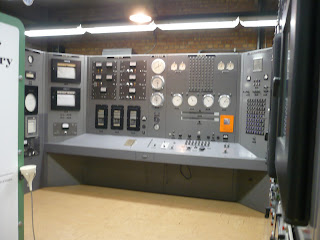 Four years later, it powered up the town of Arco. Sounds impressive, huh? Our tour guide told us that it was only for a couple of hours in the middle of the night for a publicity stunt. Remember, it was just an experimental reactor.
Four years later, it powered up the town of Arco. Sounds impressive, huh? Our tour guide told us that it was only for a couple of hours in the middle of the night for a publicity stunt. Remember, it was just an experimental reactor.Now it's a National Historic Landmark and a museum. EBR #1 was deactivated in 1964, so the technology seems archaic to those who didn't grow up thinking stuff like this was state-of-the-art.
Our guide Jasmine started the tour with a brief explanation of nuclear fission. I told her that most of what I knew about it came from when I was a kid watching a thing Walt Disney produced using mouse traps and ping pong balls. She thought that was pretty good.
When she first took us into the building, she explained that there was asbestos in the walls, but it was a very minute quantity and we didn't have to worry about itl. You should have seen the look on her face when I told her that we used asbestos pads like in our high school chemistry labs!
Jasmine told us the guys who were on the project signed their names on the wall in chalk to commemorate the historic event. Since it was 1951, they wouldn't let the women who worked there add their names--even though the janitor's name is listed! Took them until 1995 to put up a plaque to acknowledge the women.
Another story I liked was the one about the rod farm, where they stored the fuel rods. Each one is numbered and recorded. But if you look carefully, there's no "L5". First no one noticed. When a tourist asked about it, they went crazy trying to figure out what happened to it.
They didn't lose it--when they repainted the floor, they accidentally skipped L5.
What more can I say about this? I'm sure you don't want technical stuff. I didn't either.
There are a few more pictures here: EBR #1 NHS
What more can I say about this? I'm sure you don't want technical stuff. I didn't either.
There are a few more pictures here: EBR #1 NHS






